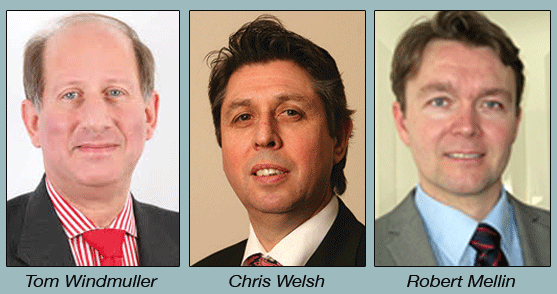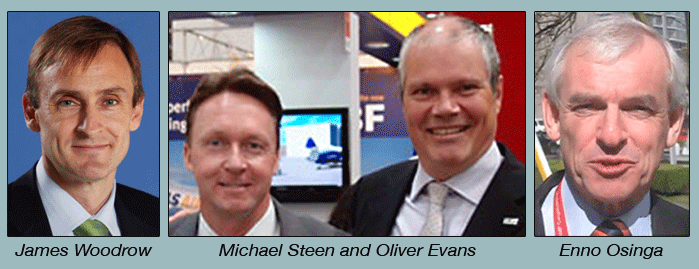
As you read this a considerable
number of time zones away, most attendees of the WCS have slept off their
jet lag and attended sessions of the IATA World Cargo Symposium in Shanghai—most
delegates going for the open-plenary ‘getting started’ sessions
of this three-day event; some for the closed ‘invitation only’
sessions, and some just taking the opportunity to do some extensive networking
while the opportunity presents itself.
Maybe it is because it is still early in
the year, but there is something to be said for many functionaries from
all aspects of the air cargo business together at one location, and in
many cases measurable results must be brought home to justify the considerable
time and expense of travel and lodging oneself halfway across the globe.
Were he here making a movie, film director
Sergio Leone would probably call the sessions a mix of the good, the bad,
and the mediocre:
 At
the top of the afternoon session was Tom Windmuller, IATA SVP APCS, with
panelists Robert Mellin, head of Distribution and Logistics, Ericsson;
Alex Xu, Supply Chain director of Lilly Pharma, Suzhou; and Chris Welsh,
secretary general of the Global Shipper’s forum. At
the top of the afternoon session was Tom Windmuller, IATA SVP APCS, with
panelists Robert Mellin, head of Distribution and Logistics, Ericsson;
Alex Xu, Supply Chain director of Lilly Pharma, Suzhou; and Chris Welsh,
secretary general of the Global Shipper’s forum.
While most attendees of this session were
still sorting business cards collected during lunchtime and beforehand,
as well as digesting the “networking and lunch,” the backdrop
to anticipation and in some cases apathy was a rather mediocre discussion.
While Robert Mellin raised some valid points
about the “customer experience” seen from the shipper’s
end of the supply chain, these points were hardly new and had been dragged
out in public before:
Getting operators, forwarders, and shippers
to innovate together and significantly increasing the degree of collaboration
between all parties concerned, as well as Mr. Mellin’s challenge
that forwarders should grant shippers more access to operators and the
succinct need for jointly optimized processes all across the supply chain
involving all stakeholders, thus creating the potential for gains for
everyone—it all drew little to no reaction from the audience.
Maybe it was the time zone or lunch, but
this session just seemed flat.
Marco Seabury
Scores
Heads snapped to attention when Marco Bloemen,
SVP of Seabury Group, delivered insights about the impact of recent key
trends to the air transport industry.
While probably based on the same data and
facts most everyone claims to have, to a large degree based on the IATA
WATS, the manner in which Mr. Bloemen crossed the t’s and dotted
the i’s seemingly convinced his audience that this guy had a message,
so listen up.
 Mr. Bloemen had identified three main factors
in the business today: The recent drop in fuel prices, parked freighter
aircraft being put back into service, and the air cargo industry being
slated for growth again.
Mr. Bloemen had identified three main factors
in the business today: The recent drop in fuel prices, parked freighter
aircraft being put back into service, and the air cargo industry being
slated for growth again.
While IATA is forecasting a drop of fuel
prices by 14 percent, the International Energy Agency IEA forecasted a
45 percent drop, which is probably also a good indicator about the accuracy
of IATA’s economic forecasts.
Mr. Bloemen predicted that the drop in fuel
prices would most likely offset the yield losses and developed a number
of alternating scenarios.
Likewise, lower fuel prices will stimulate
freighter contribution since the impact of dropping fuel prices is more
positive for the freighter business than it is in the bellyhold-only sector.
In addition, Mr. Bloemen outlined air cargo
will most probably see freighters currently in storage put back into service,
explaining that the capacity recently introduced to the market is made
up of two-thirds bellyhold-only capacity and the rest attributable to
new freighters and new conversions.
As there are currently 110 widebody all-cargo
aircraft in storage, to bring them back into service may have “a
limited impact”—the equivalent of sixteen 747 freighters would
roughly translate to a 1% capacity increase, and the return-to-service
of obsolete aircraft like Boeing’s 747-100 and -200 types is unlikely
while the -400’s are still the backbone of the cargo industry.
Since capacity in storage fluctuates with
the market growth this is more or less an organic mechanism.
As for the air cargo sector being slated
for growth again, Mr. Bloemen noted that four out of seven additional
cargo tons in 2014 came from China, and that players such as Zhengzhou’s
Foxconn factory were continuing to be a major driver of the Chinese mobile
exports.
However, Mr. Bloemen questioned whether
this growth in China is a sustainable one or more a temporary bubble—the
unsaid byline being that a shift in production to alternate locations
would likely take time, but is taking place.
So while we have accounted for the mediocre
as well as the good of this WCS evening session, there still was, we dare
say, a less than spectacular session.
Déjà
Vu All Over Again

A panel discussion about “Matching supply and demand
and meeting customer expectations,” chaired by Enno Osinga SVP Cargo
and vice chairman at TIACA, with hopeful panelists like Oliver Evans,
Swiss World Cargo chief cargo officer; James Woodrow, director Cargo for
Cathay Pacific; and Michael Steen, CCO and EVP of Atlas Air seemed to
many in the audience like it was on life support.
Probably the most charitable thing to be
said about this session is that although the panel sounded recorded, it
was indeed live, although it bore an eerie resemblance to statements put
forward by pretty much the same players during the October 2014 TIACA
Air Cargo Forum.
While the air cargo business needs prominent
figureheads and clear thinking, too much thought process and wordage is
expressed over and over again, sending identical messages to the industry.
The net result is that this ongoing discussion
effectively obliterates the need for multiple major trade events and waters
down the distinctive identity of these conferences.
Don Vito |





